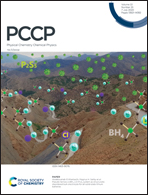Anomaly in the stability of the hydroxides of icosagens (B and Al) and their noble gas (Xe and Rn) derivatives: a comparative study†
Abstract
Motivated by the discovery of neutral noble gas hydrides, herein, we have explored the possibility of the existence of a novel class of neutral noble gas compounds, HNgBO, HNgOB, HNgAlO and HNgOAl (Ng = Xe and Rn), through the insertion of a Ng atom into the hydroxides of icosagens and their isomers, namely, HBO, HOB, HAlO and HOAl. Second-order Møller–Plesset perturbation theory (MP2), density functional theory (DFT), and coupled-cluster theory (CCSD(T))-based methods have been employed to investigate the structures, stabilities, energetics, harmonic vibrational frequencies, and charge distribution of the predicted molecules. The HXeBO, HXeOAl, HRnBO, HRnAlO and HRnOAl molecules are found to be thermodynamically stable with respect to all plausible 2-body and 3-body dissociation channels except the 2-body dissociation pathway, leading to the formation of global minimum products (Ng + HBO), (Ng + HOAl) and (Ng + HAlO). However, the very large activation energy barrier heights provide enough kinetic stability to the predicted metastable molecules, which in turn can prevent them from dissociating into the global minimum products. Between the HNgBO-HNgOB isomers, HNgBO is found to be more stable, where both HNgBO and the precursor molecule HBO are linear. On the other hand, HNgOAl is more stable between the HNgAlO–HNgOAl isomers, where the precursor molecule HOAl is bent and HNgOAl is linear in contradiction and in agreement with Walsh's rule, respectively. Moreover, in contrast to the more stable HNgBO case, where the Ng atom is bonded with the icosagen atom, in the more stable HNgOAl, the Ng atom is connected to the chalcogen atom. All the detailed aforementioned analyses concerning the predicted molecules clearly indicate that a strong covalent bond exists between the H and Ng atoms, while an ionic interaction is found between the Ng and B atoms in HNgBO and Ng and O atoms in the HNgOAl molecules. In addition, the charge distribution and atoms-in-molecules (AIM) analyses are in agreement with the above-mentioned conclusion and also suggest that the predicted metastable HNgBO and HNgOAl molecules should essentially exist in the form of [HNg]+[BO]− and [HNg]+[OAl]−, respectively. All the calculated results reported in this work indicate that it might be possible to prepare and characterize the predicted molecules via suitable experimental technique(s) under cryogenic conditions.



 Please wait while we load your content...
Please wait while we load your content...